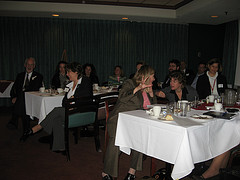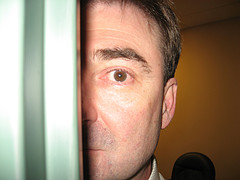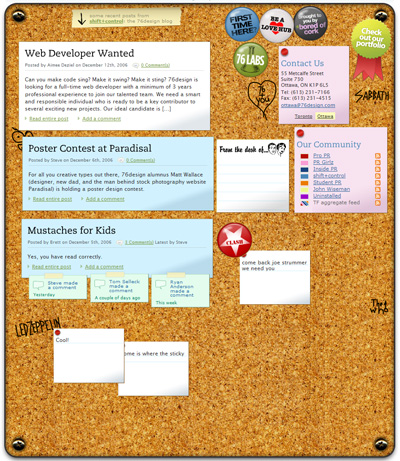Wishing you a happy, healthy and peaceful holiday!


Wishing you a happy, healthy and peaceful holiday!

So, there I was, delivering a presentation on “Sustaining a Successful Blog: If You Build, Will they Come?” The crowd of approximately 30 attendees had each paid $2,000 to attend a two day conference on new media.
 As I began my presentation, I asked a few questions to gauge the knowledge and engagement level of the audience. And of these thirty people who had paid a lot of money to hear my presentation on sustaining a successful blog – how many actually had a blog? None. Zero. Nada.
As I began my presentation, I asked a few questions to gauge the knowledge and engagement level of the audience. And of these thirty people who had paid a lot of money to hear my presentation on sustaining a successful blog – how many actually had a blog? None. Zero. Nada.
Note to self: Don’t overestimate the rate of adoption of social media. There’s a lot of curiosity. But it’s still early days.
What do you think? Is social media breaking into the mainstream? What is holding back broader adoption?
In the past few weeks, I’ve conducted career planning sessions with several of the consultants who work with me. We structure these reviews in two parts: a look back at what worked well and what didn’t work as well during the past year followed by goal setting for the coming year. We ask the employees to take the lead in completing a questionnaire that focuses our discussion around these topics. This requires them to take the time to think about what’s really going on and what they really want.
 As the leader of a team of highly talented, creative people, I know that I can count on them coming to work each day only if they truly enjoy what they are doing, and if they feel appreciated by their colleagues and challenged by the work. (For people who are good in consulting, money is never the issue.)
As the leader of a team of highly talented, creative people, I know that I can count on them coming to work each day only if they truly enjoy what they are doing, and if they feel appreciated by their colleagues and challenged by the work. (For people who are good in consulting, money is never the issue.)
We therefore focus on putting together a plan for each person that will help her to grow and give her a sense of accomplishment. Over time, we have learned that this can best be done by following two related guidelines.
First, build next year’s objectives around the employee’s demonstrated strengths. In school, our teachers drilled us on the subjects on which we were weakest. And we hated it.
 But the working world doesn’t have to be like school was. If an employee is not good at something, we don’t have to force them to improve on that (unless they really want to.) We can always find other employees who will be good at these things. Instead, we can channel each employee to focus on and further develop those skills and areas of expertise in which she has already demonstrated strength.
But the working world doesn’t have to be like school was. If an employee is not good at something, we don’t have to force them to improve on that (unless they really want to.) We can always find other employees who will be good at these things. Instead, we can channel each employee to focus on and further develop those skills and areas of expertise in which she has already demonstrated strength.
Second, we add another dimension. Each employee should like the things that she is doing. We’ve all seen workers who do things that they are really good at – and that they absolutely hate doing. Again, there’s no need for this to happen in a well managed services firm. With foresight and discipline, people should be able to follow their passions. As management expert (and Thornley Fallis client) David Maister says, “Success comes from doing what you enjoy. If you don’t enjoy it, how could it be called success?”
If I do my job well, I will hire people who have both strengths and passions that we can match to our business opportunities. And if I do this, I will be surrounded by happy, fulfilled, enthusiastic colleagues who are doing great work for our clients.
Do you think we have the right approach to career planning? What approach does your company take to the challenge of guiding employees to grow and prosper?
 The success of the relationship between a client and a public relations firm can be predetermined by the expectations they establish at the outset. Having realistic and achievable expectations is an essential building block of strong relationships.
The success of the relationship between a client and a public relations firm can be predetermined by the expectations they establish at the outset. Having realistic and achievable expectations is an essential building block of strong relationships.
In this week’s Inside PR podcast, Terry Fallis and David Jones suggest five questions that a prospective client should ask a PR firm in order to determine if their fit is right. These five questions are:
Terry’s and David’s excellent discussion of this topic can be found in Inside PR #37. Worthwhile listening for both public relations consultants and prospective clients of PR firms.
Shel Israel and Kami Huyse tagged me in the five secrets meme. Normally, I don’t give out secrets about myself. But, hey, it’s Shel and Kami who asked. So, I’ve just gotta stand up and salute.
1) I worked my way through university playing keyboards (Hammond organ, Fender electric piano and Leslie amplifier) in cover bands. The bands were good. I was the weak link in each one. But heck, we had a lot of fun and it paid the bills.
2) I grew up on British sports cars. I initially owned a Triumph Spitfire and then an MGB. After I rolled the MGB (and lived to talk about it), I opted for the TR7. It had a hard top. Because of my love for British cars, I soon learned what wiring smelled like when it shorted and I became very familiar with the inside of garages and mechanics’ bills.
 3) I learned my first hard lesson in media relations at the 1978 Liberal Party National Convention. I was the President of the Young Liberals of Canada that year and, as was expected of Young Liberals, we sponsored a policy resolution calling for the decriminalization of marijuana. It was a slow news day and one reporter, Doug Small of Canadian Press, kept asking me whether I was supporting the resolution because I smoked marijuana myself. I dodged him through the day. But late at night in the hospitality suites, he grabbed me again. I was pretty taken by the fact that a nationally known reporter kept talking to me, so I gave him a smart alec comment that “I wouldn’t want my mother to know.” Yep. You guessed it. The headline on page one of my hometown newspaper the next day was “Young Liberal President smokes pot; doesn’t want his mother to know.”
3) I learned my first hard lesson in media relations at the 1978 Liberal Party National Convention. I was the President of the Young Liberals of Canada that year and, as was expected of Young Liberals, we sponsored a policy resolution calling for the decriminalization of marijuana. It was a slow news day and one reporter, Doug Small of Canadian Press, kept asking me whether I was supporting the resolution because I smoked marijuana myself. I dodged him through the day. But late at night in the hospitality suites, he grabbed me again. I was pretty taken by the fact that a nationally known reporter kept talking to me, so I gave him a smart alec comment that “I wouldn’t want my mother to know.” Yep. You guessed it. The headline on page one of my hometown newspaper the next day was “Young Liberal President smokes pot; doesn’t want his mother to know.”
4) The first record I ever owned was The Last Time by The Rolling Stones. I preferred the Stones to the Beatles. Street smart vs. pop.
5) My middle name is Lloyd. And yes, I took a lot of school year teasing over that one.
So, there you have it. Five things you didn’t know about Joe Thornley. And probably don’t care to know.
Now, to pass it on. I hope that Jeremiah Owyang, Shel Holtz, Josh Hallett, Tod Maffin, and Michael O’Connor Clarke will share with us five secrets about themselves.
The new 76design Website incorporates a really neat web tool that the 76designers have developed: Bored of Cork.

Visitors to the 76design Website can use Bored of Cork to write and place sticky pad notes directly on the site. In this way, you can join us in creating our collective space.
Bored of Cork is the first project to come out of 76labs, the “playground” that the 76designers established to provide a focal point for the new ideas, experiments and playing around that turns them on.
We hope you like the Bored of Cork tool. If you do, please tell us. And if you think we can make it better, we’d like to hear about that too.
Bored of Cork. Enjoy.
 My colleagues at 76design have launched their new Website. I think it rocks! And I hope you like it as well.
My colleagues at 76design have launched their new Website. I think it rocks! And I hope you like it as well.
The 76design site is a companion to the Thornley Fallis site. Both sites are built around the blog and podcast content of the employees who work at the companies. This “social media design” enables visitors to learn about the companies through the blog postings of the people who work here. People like Michael O’Connor Clarke, Chris Clarke, Terry Fallis, the PR Girlz, the 76design team and me.
 We designed our Websites this way because we understand that companies are in essence the people who work for them. And we want visitors to come to know us through the eyes of our people. If we are successful in creating an environment that attracts and supports creative, thoughtful people who are passionate about their work, this will show through. And we will be successful.
We designed our Websites this way because we understand that companies are in essence the people who work for them. And we want visitors to come to know us through the eyes of our people. If we are successful in creating an environment that attracts and supports creative, thoughtful people who are passionate about their work, this will show through. And we will be successful.
At least that’s our belief. And as time passes, we’ll test this belief through experience.
Please let me know what you think of our sites. Do you like the approach? Does it work? How can it be improved?
I’m back after a five day trip for a family wedding in Tequisquiapan, Mexico.
The geographic centre of Mexico in the mountains north of Mexico City.


If you ever have a chance to go there, jump at it. You’ll find yourself in a beautiful place with wonderful people.
Now I’m back in Ottawa. Refreshed and ready to start posting again.
 I’ll be offline for the next few days. If you’ve left a comment on a post, I’ll moderate it as soon as I am back online on Monday.
I’ll be offline for the next few days. If you’ve left a comment on a post, I’ll moderate it as soon as I am back online on Monday.
 Tod Maffin knows how to make Google sing. And he shares his tips for using Google on the Inside the CBC blog.
Tod Maffin knows how to make Google sing. And he shares his tips for using Google on the Inside the CBC blog.
Tod is posting one video every day this week. He has already posted Part 1, Part 2 and Part 3.
Watch for Part 4 and Part 5 to appear on the Inside the CBC blog Thursday and Friday.